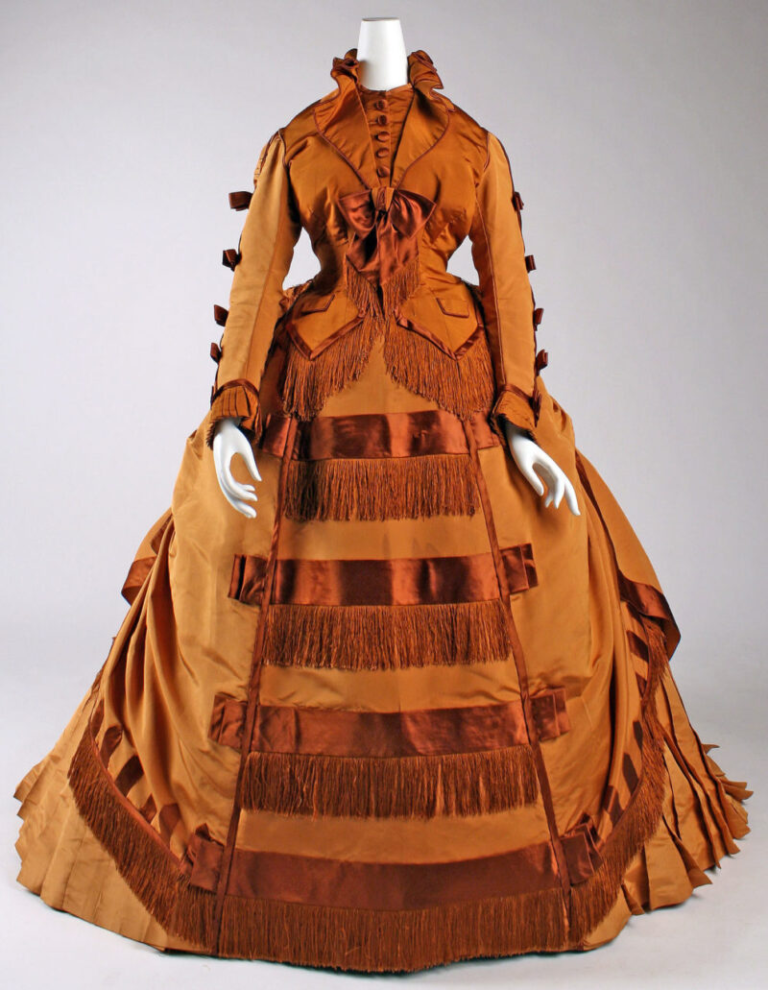The Gilded Age, a term coined by Mark Twain, refers to the period in the United States from the 1870s to the early 1900s. This era was marked by rapid industrialization, economic growth, and a burgeoning upper class that displayed their wealth through extravagant lifestyles and fashion. Gilded Age fashion reflects the social dynamics, cultural influences, and artistic movements of the time, serving as a visual representation of wealth, status, and societal change.
Key Elements of Gilded Age Fashion
Women’s Fashion
Silhouettes
Women’s clothing during the Gilded Age emphasized dramatic silhouettes. The hourglass figure was idealized, often achieved through the use of corsets and petticoats. Dresses featured wide skirts supported by crinolines or bustles, creating a pronounced shape that accentuated the waist.
Fabrics and Textiles
Luxury fabrics like silk, velvet, and brocade were commonly used, often adorned with intricate embroidery, lace, and beading. These lavish materials not only showcased wealth but also reflected the growing textile industry.
Dresses and Styles
Evening gowns were particularly opulent, often featuring low necklines and long trains. Day dresses, while still elegant, were more practical, usually incorporating high necklines and long sleeves. The use of vibrant colors and patterns, including floral designs, was also popular.
Accessories
Accessories played a crucial role in completing a Gilded Age ensemble. Women adorned themselves with hats, gloves, parasols, and elaborate jewelry, including brooches, earrings, and necklaces made of diamonds and pearls.
Men’s Fashion
Tailored Suits
Men’s fashion in the Gilded Age was characterized by tailored suits made from high-quality wool or silk. The three-piece suit, consisting of a jacket, trousers, and waistcoat, became the standard for formal occasions.
Shirts and Cravats
White dress shirts were common, often paired with cravats or bow ties. The cravat, a type of neckwear, added a touch of elegance and was an essential accessory for the well-dressed man.
Overcoats and Outerwear
As styles evolved, men began wearing overcoats, such as frock coats and tailcoats, especially during the winter months. These coats were often embellished with velvet or silk details.
Footwear and Accessories
Polished leather shoes, gloves, and hats (such as top hats or bowler hats) completed a man’s outfit, emphasizing both sophistication and status.
Influences on Gilded Age Fashion
Economic Growth
The Gilded Age was marked by significant economic growth and the rise of a wealthy elite. As industrialists and financiers accumulated vast fortunes, they sought to display their wealth through fashion. This led to increased demand for luxury goods and the emergence of high-end department stores.
Social Changes
The era also saw shifts in social structures, particularly with the rise of the middle class. While the upper class showcased opulence, the middle class adopted elements of their style in a more affordable manner, leading to the democratization of fashion.
Cultural Movements
The Gilded Age coincided with various cultural movements, including the Arts and Crafts Movement and Aestheticism, which influenced fashion design. There was a growing appreciation for craftsmanship and quality, leading to a rise in bespoke tailoring and artisanal production.
The Legacy of Gilded Age Fashion
Gilded Age fashion left a lasting impact on American style and culture:
Influence on Future Fashion
Many elements of Gilded Age fashion continued to influence styles in the early 20th century, particularly during the Edwardian era. The emphasis on luxury and craftsmanship paved the way for the haute couture movements that followed.
Representation in Popular Culture
The opulence of the Gilded Age has been romanticized in literature, film, and television, often portraying the lives of the wealthy elite. These depictions keep the aesthetics of the period alive in contemporary culture, inspiring fashion designers and enthusiasts alike.
Social Commentary
The excesses of Gilded Age fashion also serve as a commentary on social inequality. While the wealthy adorned themselves in luxury, many Americans faced poverty and hardship. This dichotomy highlights the societal issues of the time and continues to resonate in discussions about fashion and class.
Conclusion
Gilded Age fashion is a rich tapestry that reflects the complexities of a transformative era in American history. Its emphasis on opulence, craftsmanship, and social status provides insight into the lives of the wealthy elite and the cultural dynamics of the time. As fashion continues to evolve, the legacy of the Gilded Age remains a source of inspiration, serving as a reminder of the intricate relationship between style, society, and history.




